Page 2984 of 4555
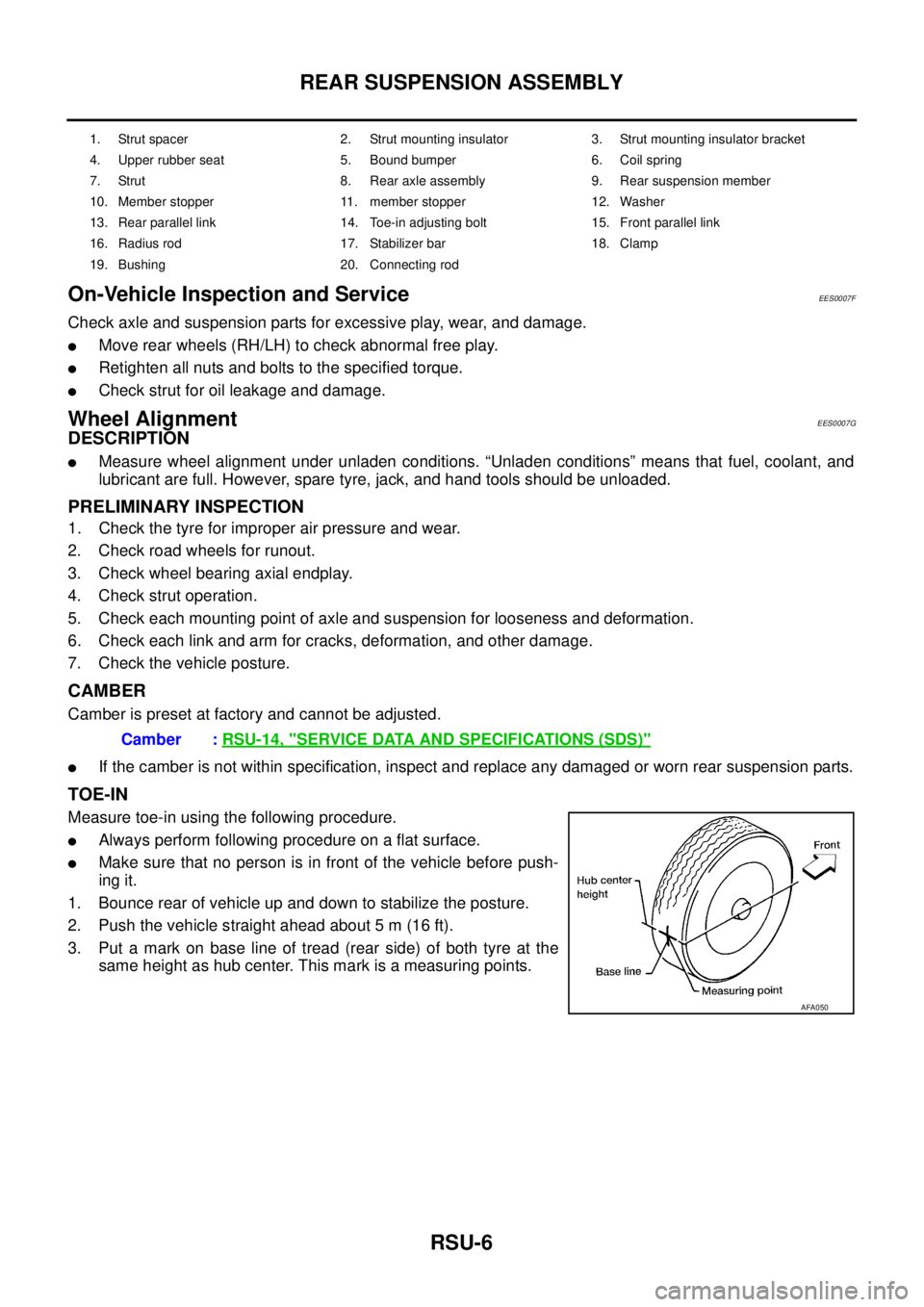
RSU-6
REAR SUSPENSION ASSEMBLY
On-Vehicle Inspection and ServiceEES0007F
Check axle and suspension parts for excessive play, wear, and damage.
�Move rear wheels (RH/LH) to check abnormal free play.
�Retighten all nuts and bolts to the specified torque.
�Check strut for oil leakage and damage.
Wheel AlignmentEES0007G
DESCRIPTION
�Measure wheel alignment under unladen conditions. “Unladen conditions” means that fuel, coolant, and
lubricant are full. However, spare tyre, jack, and hand tools should be unloaded.
PRELIMINARY INSPECTION
1. Check the tyre for improper air pressure and wear.
2. Check road wheels for runout.
3. Check wheel bearing axial endplay.
4. Check strut operation.
5. Check each mounting point of axle and suspension for looseness and deformation.
6. Check each link and arm for cracks, deformation, and other damage.
7. Check the vehicle posture.
CAMBER
Camber is preset at factory and cannot be adjusted.
�If the camber is not within specification, inspect and replace any damaged or worn rear suspension parts.
TOE-IN
Measure toe-in using the following procedure.
�Always perform following procedure on a flat surface.
�Make sure that no person is in front of the vehicle before push-
ing it.
1. Bounce rear of vehicle up and down to stabilize the posture.
2. Push the vehicle straight ahead about 5 m (16 ft).
3. Put a mark on base line of tread (rear side) of both tyre at the
same height as hub center. This mark is a measuring points.
1. Strut spacer 2. Strut mounting insulator 3. Strut mounting insulator bracket
4. Upper rubber seat 5. Bound bumper 6. Coil spring
7. Strut 8. Rear axle assembly 9. Rear suspension member
10. Member stopper 11. member stopper 12. Washer
13. Rear parallel link 14. Toe-in adjusting bolt 15. Front parallel link
16. Radius rod 17. Stabilizer bar 18. Clamp
19. Bushing 20. Connecting rod
Camber : RSU-14, "SERVICE DATA AND SPECIFICATIONS (SDS)"
AFA050
Page 2988 of 4555
RSU-10
FRONT PARALLEL LINK
FRONT PARALLEL LINKPFP:55120
Removal and InstallationEES0007J
REMOVAL
1. Remove tyre, Raise vehicle.
2. Remove wheel sensor wire.
3. Remove front parallel link mounting bolts and nuts. Remove front parallel link from vehicle.
INSPECTION AFTER REMOVAL
�Replace front parallel link assembly if it is in following condition: deformed, cracked, or damaged, or if the
bushing was damaged.
INSTALLATION
�Refer to RSU-5, "Components" for tightening torque and reverse the removal procedure for installation.
Page 2991 of 4555
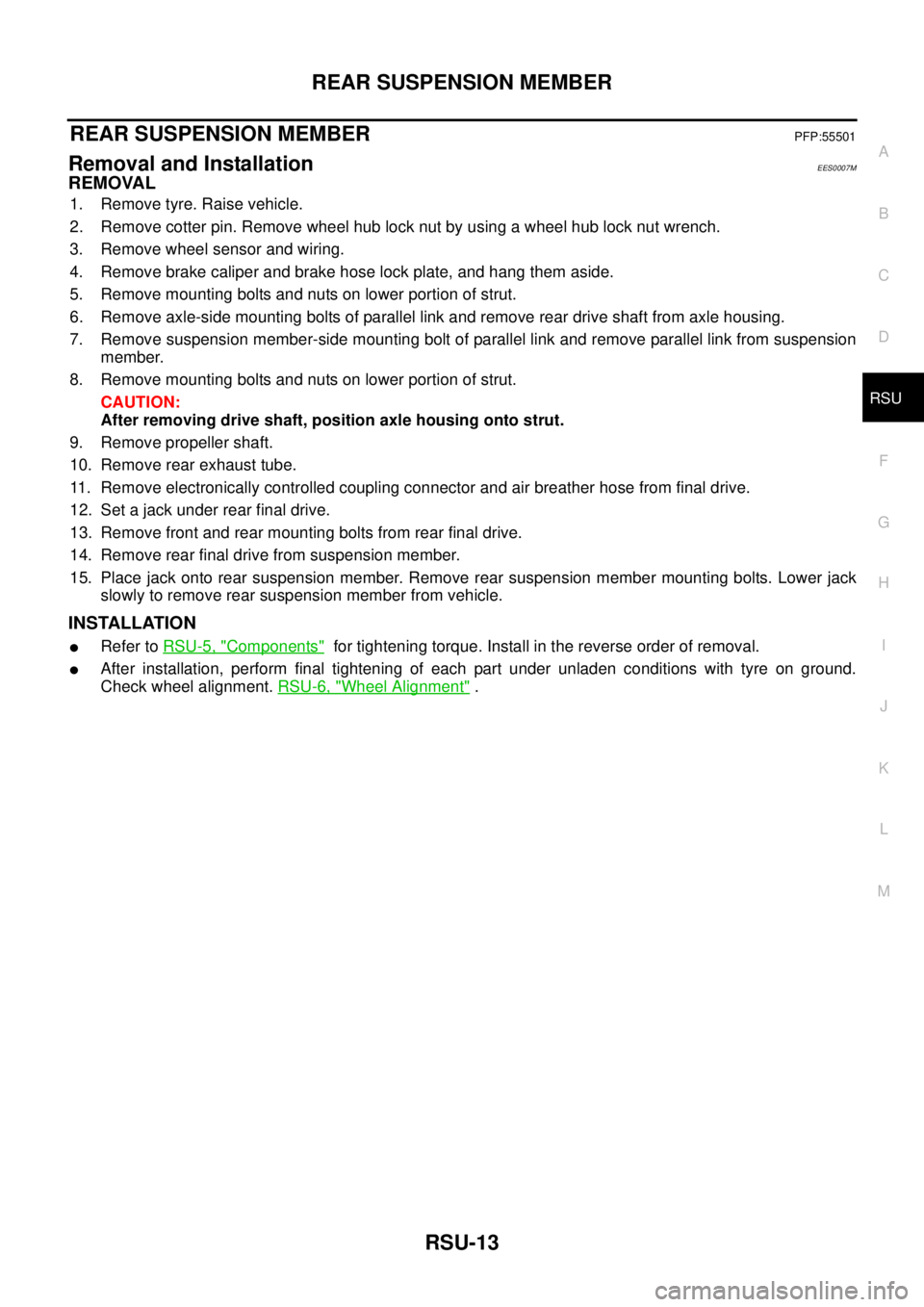
REAR SUSPENSION MEMBER
RSU-13
C
D
F
G
H
I
J
K
L
MA
B
RSU
REAR SUSPENSION MEMBERPFP:55501
Removal and InstallationEES0007M
REMOVAL
1. Remove tyre. Raise vehicle.
2. Remove cotter pin. Remove wheel hub lock nut by using a wheel hub lock nut wrench.
3. Remove wheel sensor and wiring.
4. Remove brake caliper and brake hose lock plate, and hang them aside.
5. Remove mounting bolts and nuts on lower portion of strut.
6. Remove axle-side mounting bolts of parallel link and remove rear drive shaft from axle housing.
7. Remove suspension member-side mounting bolt of parallel link and remove parallel link from suspension
member.
8. Remove mounting bolts and nuts on lower portion of strut.
CAUTION:
After removing drive shaft, position axle housing onto strut.
9. Remove propeller shaft.
10. Remove rear exhaust tube.
11. Remove electronically controlled coupling connector and air breather hose from final drive.
12. Set a jack under rear final drive.
13. Remove front and rear mounting bolts from rear final drive.
14. Remove rear final drive from suspension member.
15. Place jack onto rear suspension member. Remove rear suspension member mounting bolts. Lower jack
slowly to remove rear suspension member from vehicle.
INSTALLATION
�Refer to RSU-5, "Components" for tightening torque. Install in the reverse order of removal.
�After installation, perform final tightening of each part under unladen conditions with tyre on ground.
Check wheel alignment. RSU-6, "
Wheel Alignment" .
Page 2997 of 4555
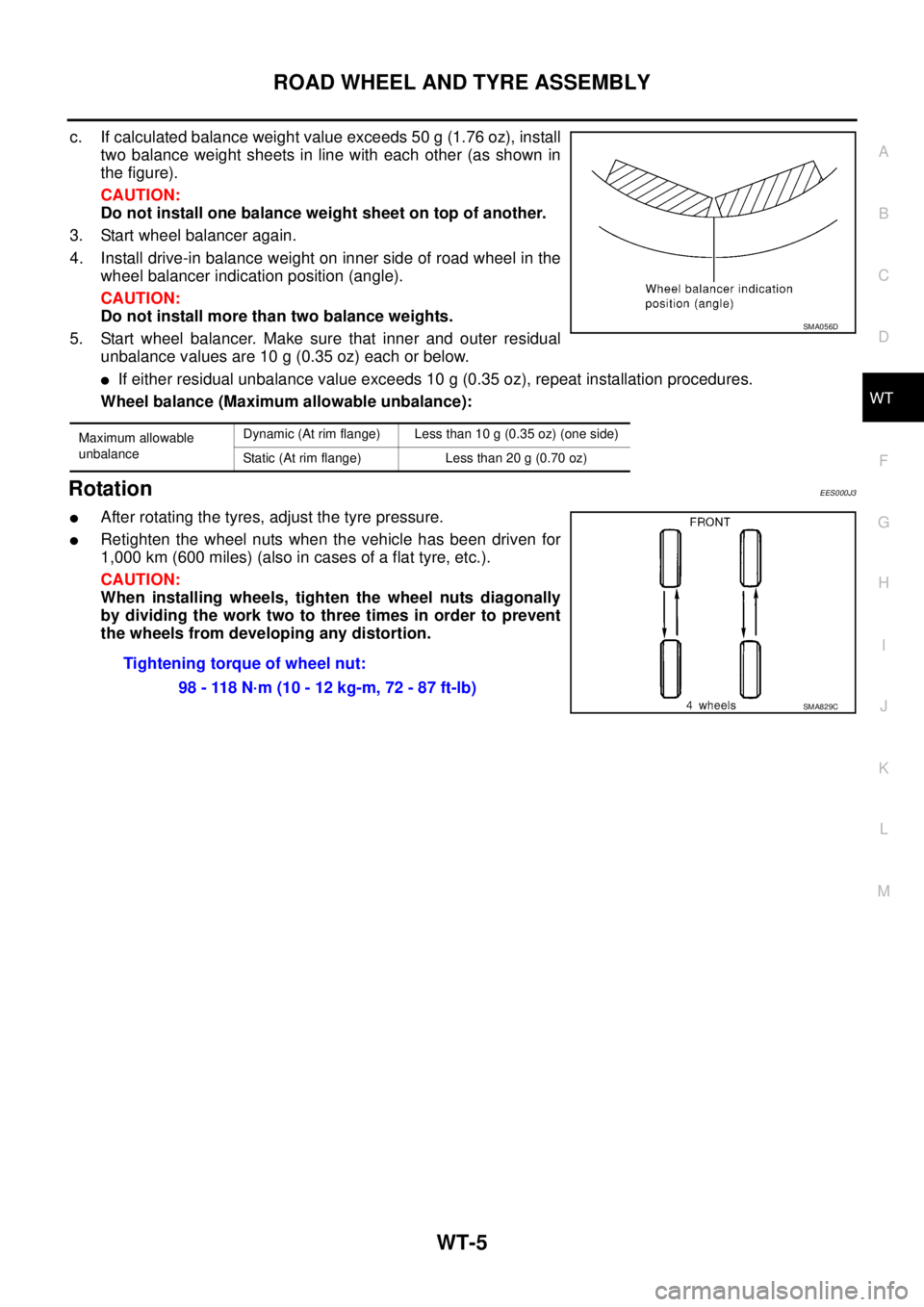
ROAD WHEEL AND TYRE ASSEMBLY
WT-5
C
D
F
G
H
I
J
K
L
MA
B
WT
c. If calculated balance weight value exceeds 50 g (1.76 oz), install
two balance weight sheets in line with each other (as shown in
the figure).
CAUTION:
Do not install one balance weight sheet on top of another.
3. Start wheel balancer again.
4. Install drive-in balance weight on inner side of road wheel in the
wheel balancer indication position (angle).
CAUTION:
Do not install more than two balance weights.
5. Start wheel balancer. Make sure that inner and outer residual
unbalance values are 10 g (0.35 oz) each or below.
�If either residual unbalance value exceeds 10 g (0.35 oz), repeat installation procedures.
Wheel balance (Maximum allowable unbalance):
RotationEES000J3
�After rotating the tyres, adjust the tyre pressure.
�Retighten the wheel nuts when the vehicle has been driven for
1,000 km (600 miles) (also in cases of a flat tyre, etc.).
CAUTION:
When installing wheels, tighten the wheel nuts diagonally
by dividing the work two to three times in order to prevent
the wheels from developing any distortion.
Maximum allowable
unbalanceDynamic (At rim flange) Less than 10 g (0.35 oz) (one side)
Static (At rim flange) Less than 20 g (0.70 oz)
SMA056D
Tightening torque of wheel nut:
98 - 118 N·m (10 - 12 kg-m, 72 - 87 ft-lb)
SMA829C
Page 3010 of 4555
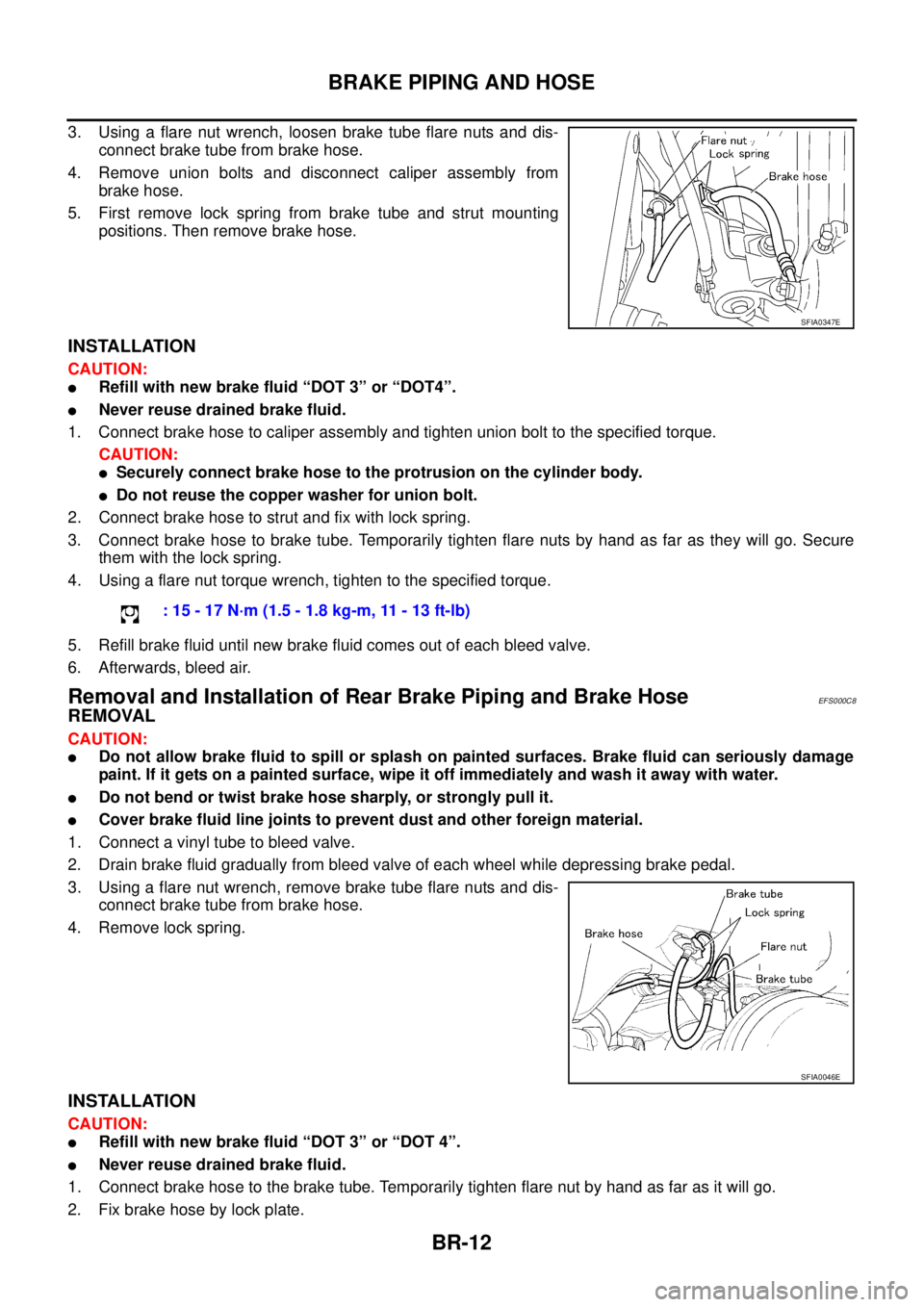
BR-12
BRAKE PIPING AND HOSE
3. Using a flare nut wrench, loosen brake tube flare nuts and dis-
connect brake tube from brake hose.
4. Remove union bolts and disconnect caliper assembly from
brake hose.
5. First remove lock spring from brake tube and strut mounting
positions. Then remove brake hose.
INSTALLATION
CAUTION:
�Refill with new brake fluid “DOT 3” or “DOT4”.
�Never reuse drained brake fluid.
1. Connect brake hose to caliper assembly and tighten union bolt to the specified torque.
CAUTION:
�Securely connect brake hose to the protrusion on the cylinder body.
�Do not reuse the copper washer for union bolt.
2. Connect brake hose to strut and fix with lock spring.
3. Connect brake hose to brake tube. Temporarily tighten flare nuts by hand as far as they will go. Secure
them with the lock spring.
4. Using a flare nut torque wrench, tighten to the specified torque.
5. Refill brake fluid until new brake fluid comes out of each bleed valve.
6. Afterwards, bleed air.
Removal and Installation of Rear Brake Piping and Brake HoseEFS000C8
REMOVAL
CAUTION:
�Do not allow brake fluid to spill or splash on painted surfaces. Brake fluid can seriously damage
paint. If it gets on a painted surface, wipe it off immediately and wash it away with water.
�Do not bend or twist brake hose sharply, or strongly pull it.
�Cover brake fluid line joints to prevent dust and other foreign material.
1. Connect a vinyl tube to bleed valve.
2. Drain brake fluid gradually from bleed valve of each wheel while depressing brake pedal.
3. Using a flare nut wrench, remove brake tube flare nuts and dis-
connect brake tube from brake hose.
4. Remove lock spring.
INSTALLATION
CAUTION:
�Refill with new brake fluid “DOT 3” or “DOT 4”.
�Never reuse drained brake fluid.
1. Connect brake hose to the brake tube. Temporarily tighten flare nut by hand as far as it will go.
2. Fix brake hose by lock plate.
SFIA0347E
: 15 - 17 N·m (1.5 - 1.8 kg-m, 11 - 13 ft-lb)
SFIA0046E
Page 3025 of 4555
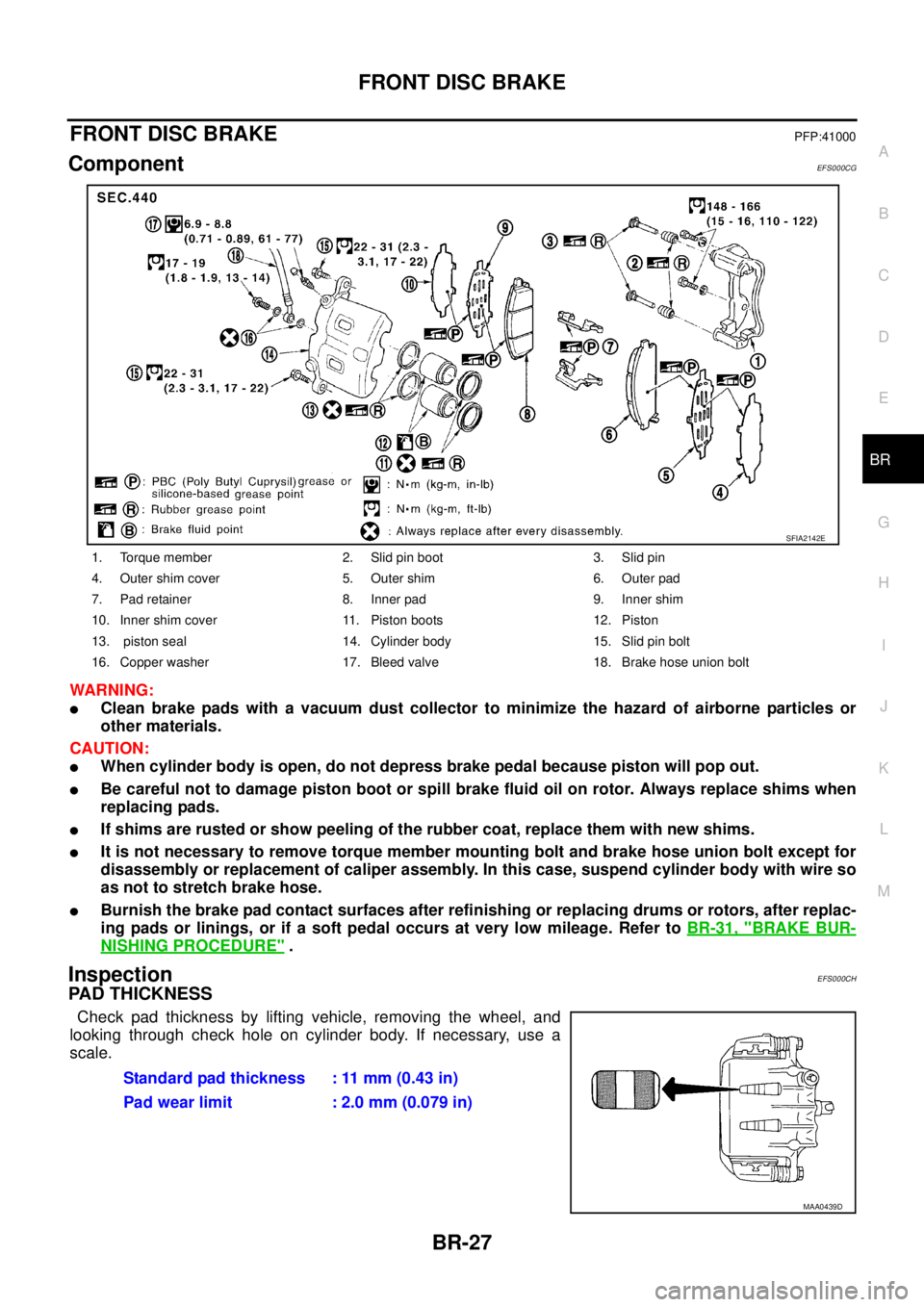
FRONT DISC BRAKE
BR-27
C
D
E
G
H
I
J
K
L
MA
B
BR
FRONT DISC BRAKEPFP:41000
ComponentEFS000CG
WARNING:
�Clean brake pads with a vacuum dust collector to minimize the hazard of airborne particles or
other materials.
CAUTION:
�When cylinder body is open, do not depress brake pedal because piston will pop out.
�Be careful not to damage piston boot or spill brake fluid oil on rotor. Always replace shims when
replacing pads.
�If shims are rusted or show peeling of the rubber coat, replace them with new shims.
�It is not necessary to remove torque member mounting bolt and brake hose union bolt except for
disassembly or replacement of caliper assembly. In this case, suspend cylinder body with wire so
as not to stretch brake hose.
�Burnish the brake pad contact surfaces after refinishing or replacing drums or rotors, after replac-
ing pads or linings, or if a soft pedal occurs at very low mileage. Refer to BR-31, "
BRAKE BUR-
NISHING PROCEDURE" .
InspectionEFS000CH
PAD THICKNESS
Check pad thickness by lifting vehicle, removing the wheel, and
looking through check hole on cylinder body. If necessary, use a
scale.
1. Torque member 2. Slid pin boot 3. Slid pin
4. Outer shim cover 5. Outer shim 6. Outer pad
7. Pad retainer 8. Inner pad 9. Inner shim
10. Inner shim cover 11. Piston boots 12. Piston
13. piston seal 14. Cylinder body 15. Slid pin bolt
16. Copper washer 17. Bleed valve 18. Brake hose union bolt
SFIA2142E
Standard pad thickness : 11 mm (0.43 in)
Pad wear limit : 2.0 mm (0.079 in)
MAA0439D
Page 3030 of 4555
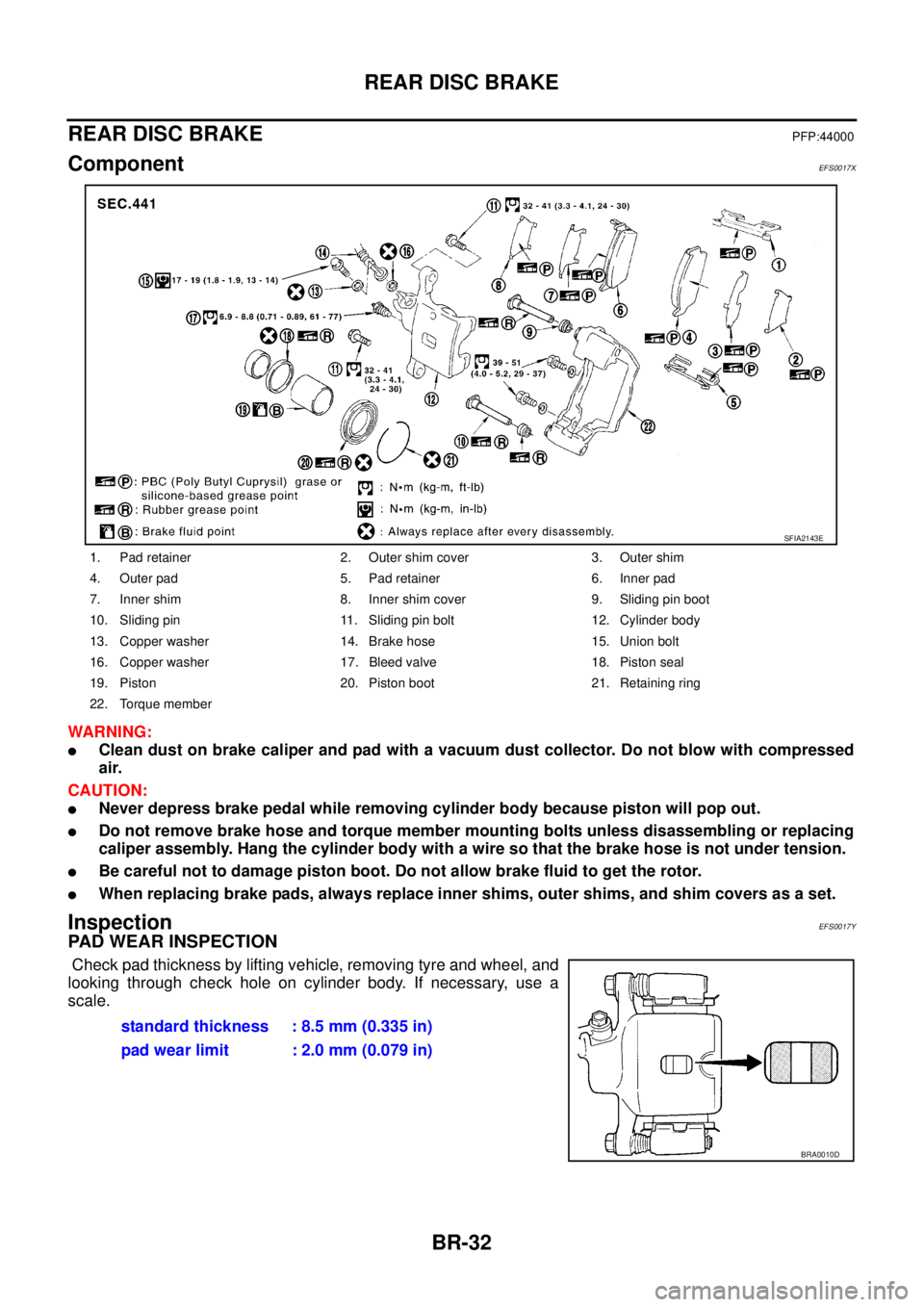
BR-32
REAR DISC BRAKE
REAR DISC BRAKEPFP:44000
ComponentEFS0017X
WARNING:
�Clean dust on brake caliper and pad with a vacuum dust collector. Do not blow with compressed
air.
CAUTION:
�Never depress brake pedal while removing cylinder body because piston will pop out.
�Do not remove brake hose and torque member mounting bolts unless disassembling or replacing
caliper assembly. Hang the cylinder body with a wire so that the brake hose is not under tension.
�Be careful not to damage piston boot. Do not allow brake fluid to get the rotor.
�When replacing brake pads, always replace inner shims, outer shims, and shim covers as a set.
InspectionEFS0017Y
PAD WEAR INSPECTION
Check pad thickness by lifting vehicle, removing tyre and wheel, and
looking through check hole on cylinder body. If necessary, use a
scale.
1. Pad retainer 2. Outer shim cover 3. Outer shim
4. Outer pad 5. Pad retainer 6. Inner pad
7. Inner shim 8. Inner shim cover 9. Sliding pin boot
10. Sliding pin 11. Sliding pin bolt 12. Cylinder body
13. Copper washer 14. Brake hose 15. Union bolt
16. Copper washer 17. Bleed valve 18. Piston seal
19. Piston 20. Piston boot 21. Retaining ring
22. Torque member
SFIA2143E
standard thickness : 8.5 mm (0.335 in)
pad wear limit : 2.0 mm (0.079 in)
BRA0010D
Page 3094 of 4555
![NISSAN X-TRAIL 2005 Service Repair Manual BRC-46
[ABS]
WHEEL SENSORS
WHEEL SENSORSPFP:47910
Removal and InstallationEFS004GR
REMOVAL
Pay attention to the following when removing sensor.
CAUTION:
�As much as possible, avoid rotating sensor w NISSAN X-TRAIL 2005 Service Repair Manual BRC-46
[ABS]
WHEEL SENSORS
WHEEL SENSORSPFP:47910
Removal and InstallationEFS004GR
REMOVAL
Pay attention to the following when removing sensor.
CAUTION:
�As much as possible, avoid rotating sensor w](/manual-img/5/57403/w960_57403-3093.png)
BRC-46
[ABS]
WHEEL SENSORS
WHEEL SENSORSPFP:47910
Removal and InstallationEFS004GR
REMOVAL
Pay attention to the following when removing sensor.
CAUTION:
�As much as possible, avoid rotating sensor when removing it. Pull sensors out without pulling on
sensor harness.
�Take care to avoid damaging sensor edges or rotor teeth. Remove wheel sensor first before
removing front or rear wheel hub. This is to avoid damage to sensor wiring and loss of sensor
function.
INSTALLATION
Pay attention to the following when installing sensor. Tighten installation bolts to specified torques.
�When installing, check that there is no foreign material such as iron chips on pick-up and mounting hole of
the sensor. Check that no foreign material has been caught in the sensor rotor. Remove any foreign mate-
rial and clean the mount.
�When installing front sensor, be sure to press rubber grommets in until they lock at the three locations
shown in the figure (2 at strut and 1 at body panel). When installed, harness must not be twisted.
SFIA1100E